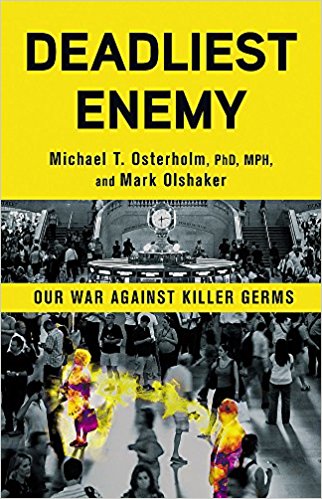
Deadliest Enemy: Our War Against Killer Germs. Michael T. Osterholm. Boston: Little, Brown and Company, 2017. 352 pages. ISBN 0316343692
The harsh texture of a sore throat, the rolling feeling of nausea, or the unbearable burn of a fever are all common symptoms we expect modern medicine easily to alleviate. We live in a day and age where doctors prescribe the cure for any discomfort and allow people to continue with their lives. Or do they? In Deadliest Enemy, Dr Michael Osterholm, a world-renowned epidemiologist, and Mark Olshaker, a New York Times #1 bestselling author and Emmy Award–winning documentary filmmaker, illuminate the reality of how ignorant and unprepared society is today over the ongoing battle against infectious diseases. Dr Osterholm gives first-hand accounts and insights to the world’s most prolific epidemics and helps explain the importance of understanding both the hard science and how humans respond to these diseases. The reader is given the opportunity not only to learn the science behind humanity’s turbulent relationship with the microscopic world, but also media responses and political turmoil involved in effectively arming ourselves against an oncoming “germ” attack.
The book begins each chapter with a unique quote, from doctors to songwriters, which helps highlight the main ideas the authors want to emphasize within that chapter. Readers then delve into the mind of Dr Osterholm as he recounts both his first-hand observations of the most infamous diseases and knowledge of the terrifying world of epidemiology. He begins by narrating the rise of AIDS and his attempt to stop the virus before it could take hold in America. He highlights the various questions and clues that lead to the discovery of the HIV virus and the people who spearheaded that discovery. Furthermore, he expresses the frustration felt as politicians gave false promises and refused to change policies. All the while, the public refused to change their behaviors to try and thwart its spread throughout the nation. Many other stories and cases of infectious diseases that are still predominant today, such as Ebola, are given the same detailed review of their past and present relationship with humans.
Dr Osterholm uses this book to guide readers into understanding who, what, when, where, and why some diseases become public health menaces. He describes the history of various infectious diseases (from influenza to Zika), the origins of epidemiology, the evolution of pathogens, and the creation of vaccines. Furthermore, this book exposes the world’s current vulnerabilities to the next major crisis, such as how our ability to travel across seas within hours can be used to quickly infect populations throughout the world; the way a research paper may give the key to Pandora’s box to a terrorist and allow a weapon more powerful than a nuclear bomb to devastate a nation; or how the overuse of antibiotics is giving rise to super-bugs that are invulnerable to all current medications and can devastate hospitals. This book explores mankind’s progress in overcoming what were once humanity’s greatest killers and the current stagnation that foretells doom in the face of a new disease outbreak if action is not taken now. This concept is detailed in a horrifying scenario—generated by experts and widely considered a highly realistic and possible case—of how the world today would react if faced with another major influenza pandemic. However, readers are also given a silver lining as Dr Osterholm shows how new discoveries, international cooperation, and a solid plan of action can change how people view medicine and adopt preventative action as the first few steps in the effort to avert the next world pandemic.
Deadliest Enemy is a chilling read that gives a cohesive narrative to a world plagued with disease, which causes all readers to be sucked into its words. The book acts as an important warning of the precarious position in which society has placed itself, and is a fantastic outline of the continuously evolving field of epidemiology, summarizing the science used to uncover and fight back against hostile pathogens. These authors have written a dramatic and intelligent book that uses metaphors, stories, and good old science to bond with all readers interested in preparing themselves for the oncoming fallout or any reader who just likes a good old science book.
